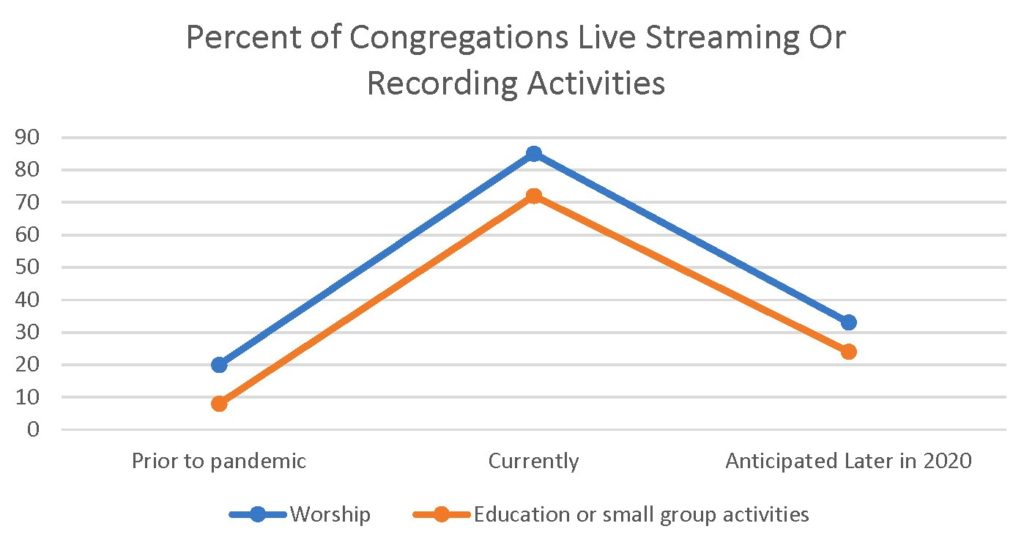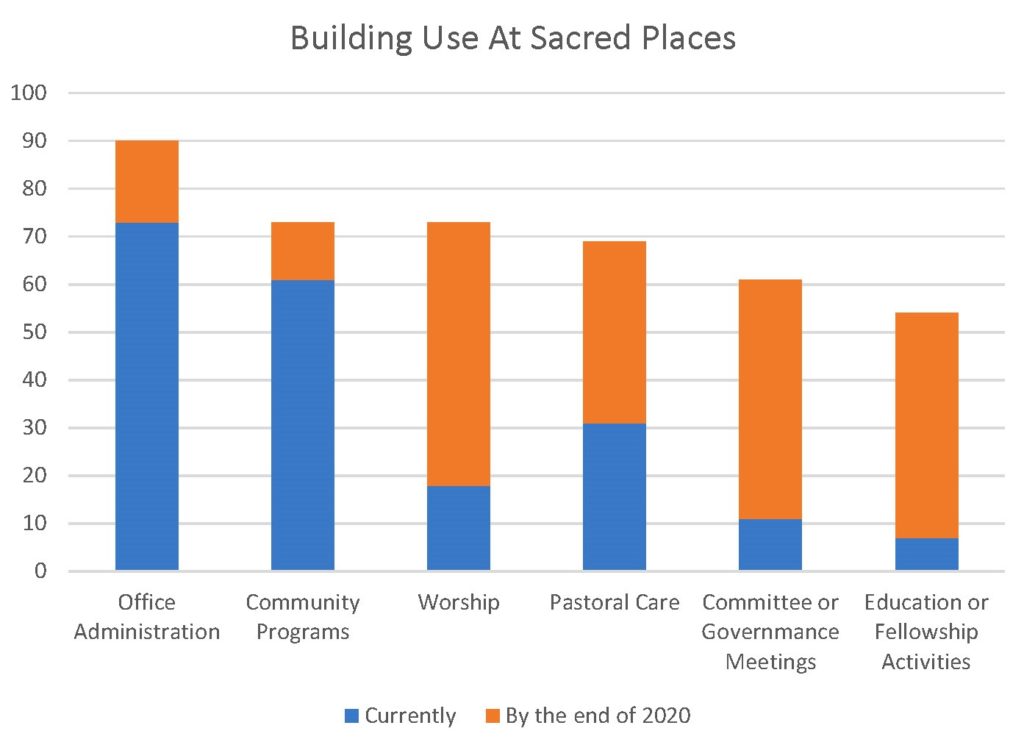Summary Findings
Disruptions caused by the pandemic have almost completely reshaped what occurs in sacred places accross America. In late June, early July of 2020, only 18% of sacred places surveyed were using their buildings for worship, but 61% were in use for community serving programs. Yet, the number of community serving programs has fallen dramatically. Only about one third of programs that existed before the pandemic are currently operating, one third are planned to resume by the end of this year, and there are no plans to resume the other third.
At America faces the COVID-19 pandemic, a prolonged economic recession, and demands for increased equity and racial justice, congregations are confronting significant challenges as they plan to resume in-person activities. While congregations have shown great resourcefulness and community-mindedness in opening programs where possible, greater investment will be needed from the wider community so these services are not lost. Partners will continue to work with congregations as they make their case for the value they provide to their communities and the impact that investment in sacred places makes on our neighborhoods, cities, and nation.
Audience and Overview
Thanks to the leaders from 131 sacred places who took the time to participate in Partners’ survey about the impact that the COVID-19 pandemic has had on their operations. Data was gathered from June 26 through July 10, 2020 from a broad variety of faith traditions (19) and locations (37 states.) This data was not scientifically sampled, and is drawn from congregations who have a connection with Partners for Sacred Places through our programs, services, and events. While the findings are not intended to be representative of American congregations as a whole, they do offer important insights into the conditions that congregations and communities are facing as a result of this pandemic, which will guide Partner’s work in the coming months.
Questions in this survey focused primarily in two areas:
1) The impact that COVID-19 has had on community serving programs, and the individuals who relied on those programs; and
2) How sacred places are currently being used, and plans for use later this year.
Impact on Community Serving Programs
The pandemic has resulted in a profound loss of community serving programs.
85% of community serving programs stopped during the pandemic. The most commonly cited reasons were guidance from government (73%), the need for social distancing (72%), the need to protect vulnerable volunteers (66%), and guidance from judicatories (49%). Only 4% of respondents reported a lack of participants as a reason to stop programs, and only 2% reported a lack of funding.
Many of these programs have resumed, with additional programs expected to resume by the end of 2020. Of the 549 surveyed community serving programs that were active before social distancing, only 34% are currently active. An additional 28% are expected to open by the end of the calendar year. However, 38% of community serving programs that existed prior to social distancing are not expected to resume by the end of 2020.

Congregations have shown themselves to be especially community-minded during the pandemic. While the total number of community programs has significantly decreased, most congregations are continuing to support some kind of community serving program. 45% of congregations are currently managing community serving programs, and an additional 15% plan to have programs active by the end of 2020. 39% are currently hosting community serving programs managed by outside organizations, and an additional 9% plan to host community serving programs by the end of the year. In total, 61% of congregations are currently hosting or managing community serving programs, despite widespread projections for lost revenue as a result of the pandemic.
In addition, several congregations have started new programs since the start of social distancing, or plan to start them by the end of 2020. The largest gain was in community feeding programs (21 new programs with 23 lost, for a net loss of 2% compared to the original number). Many respondents indicated that these programs were started due to increased need created by COVID-19. Congregations have also worked to keep community-serving programs active, despite space limitations. 61% of community-serving programs currently active are operating on-site, and 39% operating off-site.
When asked about the alternate resources that clients / participants of community serving programs had access to, the largest portion of respondents (46%) did not know what services clients were receiving, and 34% of respondents said that clients were receiving fewer services (double the 17% who were reported to receive similar services.) Responses varied significantly by program area, with some programs especially hard hit. Areas where clients were least likely to receive comparable resources are:
- Child care (42% less, 3% similar).
- Community arts programs (40% fewer, 4% similar).
- Educational services (46% fewer, 6% similar).
Areas where clients were most likely to receive comparable resources are:
- Substance abuse (30% less, 33% similar).
- Refugee services (31% less, 31% similar).
- Community health (28% fewer, 22% similar, 6% more).
- Homeless outreach (34% less, 22% similar, 5% more).
Current Building Use and Plans for Reopening
The survey also explored how activities at sacred places, other than community-serving programs, have been impacted by the COVID-19 pandemic.
There has been a dramatic increase in the number of congregations pre-recording or live streaming both worship (increase from 20% to 85%) and education or small group activities (increase from 7% to 72%). Most of the live-streaming is planned to end after in-person activities resume, but some will continue, resulting to a long-term increase in congregation’s capabilities.

While only 18% of congregations have returned to in person worship, 55% plan to return by the end of the year. The vast majority, 95%, of congregations have or are developing a plan to reopen. About half have a plan and half are in development. 75% of congregations plan to reopen in the same space, with physical modifications. 8% will use the same space with other modifications, 8% will use an alternate/outdoor space, 11% are undecided.

The percent of sacred places used for various purposes, currently (late June, early July 2020) and planned by the end of 2020.
Many of the disruptions caused by COVID-19 will not be resolved by the end of 2020. 28% of congregations have no plans to return to in-person worship by the end of the year. 30% of respondents expect the current health crisis to result in decreased revenue from lost space-use income, resulting in an overall deficit at the end of the year. 34% expect decreased revenue, but not a deficit.

[…] coronavirus pandemic continues, sacred places and community programs are being hit hard. A recent Partners for Sacred Places survey shows that only 18% of religious buildings are still being used for worship, and 85% of community […]